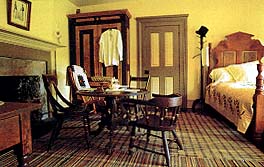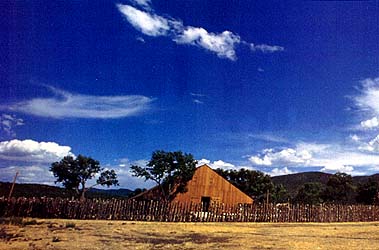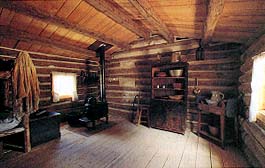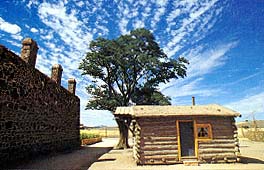“Cove Fort Today,” Ensign, June 1995, 36
Cove Fort Today
Now a popular visitors’ center, this 1867 wilderness way station was once a strategic link in the chain of settlements established by Latter-day Saint pioneers.
On 12 April 1867 President Brigham Young wrote a letter to Ira Hinckley asking him to “take charge” of building a fort on Cove Creek, located in central Utah a day’s journey from the town of Fillmore on the north or the town of Beaver on the south. This fort, built instead of a town because of the scarcity of water, was to be a way station for Latter-day Saints traveling along the “Mormon Corridor”—settlements stretching from Idaho to Nevada connected by a network of roads, telegraph lines, and postal routes. Being a man of action, Ira left his home in Coalville, Utah, on April 17 for his new assignment, his family to come later.
Between April and November 1867, quarrymen, stonemasons, and carpenters from central Utah settlements labored together to construct the fort. Built of black volcanic rock and dark limestone quarried nearby, the walls are one hundred feet long and eighteen feet high. Lumber, mostly cedar and pine, was used for the roof, twelve interior rooms, and the massive doors at the east and west ends of the fort.
For years the fort bustled with activity. “In those early days it was not isolation to be at the fort,” said Ira’s daughter, Luna. “The news of the great, growing West throbbed over the lines into the telegraph office at the fort and through [the] post office passed the news of the new western empire” delivered by Pony Express riders.1 Children laughed as they played in the inner courtyard. Daily, two stagecoaches with a variety of weary travelers rumbled up to the fort. Latter-day Saint families, some of whom were moving to new communities, unhitched their teams from their heavily loaded wagons and led the horses to the barn. Cowboys tended the tithing herds, and a blacksmith clanged metal into horseshoes with his hammer. Evening conversation was lively around the long table where each night a new variety of visitors, perhaps mail carriers, artists, miners, Indian or Spanish traders, or Latter-day Saint families, joined the Hinckley family for dinner. Afterward, everyone—Latter-day Saint or not—attended family prayer. At night the air might be filled with music as the cowboys sang around their campfire.
For more than twenty years the fort served an important function, but as times changed so did the need for the fort. By 1890 the Church leased out the fort and, after the turn of the century, sold it to the Otto Kesler family. Nearly one hundred years later, in 1989, the Hinckley family purchased the fort from the Keslers and made a gift of it to the Church as a historic site.2 Shortly afterward, efforts to restore the fort to its original condition were begun, and on 21 May 1994 President Gordon B. Hinckley, then First Counselor in the First Presidency, dedicated the Historic Cove Fort Complex.
“It is our hope that Cove Fort will serve as a modern way station—not as a shelter from physical fatigue or protection from the elements,” said Elder Stephen D. Nadauld of the Seventy, who also spoke at the dedication. “Rather, we hope it will serve as a spiritual way station where we can be reminded of the faith of our forefathers, where we can refresh our sense of sacrifice and obedience and our dedication to duty, where we can be reminded of the values of work, provident living, self-sufficiency, and family unity.”

Located just off the junction of highways I-70 and I-15 in central Utah and staffed by missionary couples, Cove Fort welcomed 137,500 visitors in 1994. (Photo by Welden Andersen.)

Small Cove Creek ran east to west through the middle of the courtyard. “Grass never had much time to grow” in the courtyard, said Ira’s niece, Ella, in a 1945 interview. “We used to keep the yard as clean as any floor. We swept the dirt down to hard-pan then sprinkled it.”3 (Photo by Welden Andersen.)

Of the six rooms on the north side of the fort, three rooms served as a private residence for the Hinckley family and the remaining three served as overnight lodgings for travelers. (Photo by David Gaunt.)

On this high desert plain, water was precious. Hauled in buckets, it was used and reused for cleaning and washing. History often overlooks the importance of kitchens and washrooms, but for Cove Fort pioneers the work carried on there was the very center of their domestic and community life. (Photo by LaRene Gaunt.)

The barn measures an impressive 60 by 60 feet. The center portion is 30 feet high, with two levels for hay and grain. Attached to the barn on the west and made of vertical cedar posts is a corral measuring 150 by 200 feet. “All cattle had to be checked at the corrals for earmarks and brands,” said Ira’s niece, Ella. “Those not marked kept the men busy with ropes and branding irons. Constant bellowing and bawling came from that quarter.”5 (Photo by Dennis Gaunt.)

The original blacksmith shop measured eighteen by twelve feet and had a sod roof. Restored in 1993, the current shop sits on the original location thirty-five yards directly west of the rear gate of the fort. A pigpen was also located west of the fort near a large pond fed by a diverted portion of Cove Creek. (Photo by LaRene Gaunt.)

The blacksmith was kept busy reshoeing the horses and oxen of travelers or repairing wagon wheels. (Photo by LaRene Gaunt.)
Above: Volunteer Steve Pratt and missionary Carvel Jackson re-create a scene from the past as they plow a row of potatoes. The Hinckley family grew herbs and vegetables in gardens on the west and south sides of the fort. Wild currants and gooseberries also flourished. Pie plants and rhubarb grew along the creek and ditch banks. A large apple orchard grew on the east side of the road, with squash growing on the ground around the trunks. (Photo by Dennis Gaunt.)

“You’d think [the cowboys] would be too tired to play jokes and tell stories,” remembered Ella Hinckley, “but … we would hear them for a long time after we went to bed, when an extra good joke made them laugh loudly.”6 (Photo by David Gaunt.)

Cove Fort served as a regional collecting station for livestock donated to the Church as tithing. Some of the cowboys that tended the herds lived in the bunkhouse, located between the fort and the barn. (Photo by Dennis Gaunt.)
Background photo by LaRene Gaunt
Since the fort’s restoration, couple missionaries, along with local residents such as Dick Davis (shown here), have formed a pioneer band and play for special occasions at the fort. (Photo by Dennis Gaunt.)
Above: The six rooms along the south side of the fort were used for business, domestic, and social activities. The kitchen and dining room were the heart of Cove Fort. When President Brigham Young’s party of ten covered wagons stopped at the fort in March 1870, the Hinckleys fed seventy-five people.4 (Photo by Welden Andersen.)
Like all missionaries at the fort, Sister Lois Jackson shares with visitors stories of the fort’s history as she conducts guided tours throughout the day. (Photo by LaRene Gaunt.)
Local resident Larry Julander is one of the volunteer blacksmiths who help create a sense of history in this restored Cove Fort complex. (Photo by David Gaunt.)
Visitors enjoy stepping back into history as they visit the fort. Here, Roger Davis experiments with a whetstone in front of the blacksmith shop. (Photo by LaRene Gaunt.)